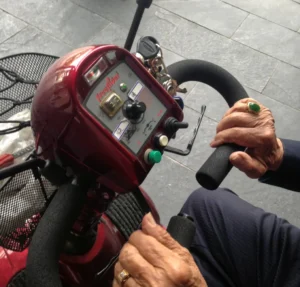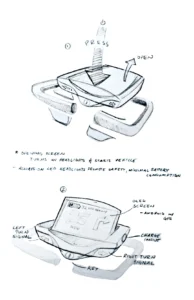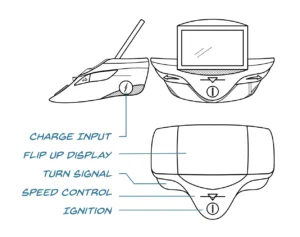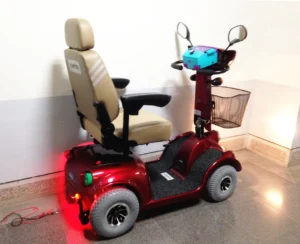Navigation for Seniors
Mobility Safety for the Elderly

Navigation for Seniors
Mobility Safety for the Elderly

Mobility scooters are a popular method of senior transportation in Taiwan.
There are several safety issues surrounding current mobility scooters.
I used UX design and research methods to build a dashboard setup that would be easy for seniors to use and would promote greater safety while traveling.
This was a collaborative effort between industrial design and engineering teams at National Cheng Kung University in Taiwan.
Background
The elderly face operational challenges when traveling in busy Taiwanese cities that lack public transit systems.
Mobility scooters have gained popularity among seniors.
These scooters have a number of advantages over traditional scooters, bicycles, and cars:
- Easy to operate
- Electric
- Slow
- Can be used in residential areas
- Low physical demand
- Quiet
- Clean
Mobility scooters have gained popularity among seniors.
These scooters have a number of advantages over traditional scooters, bicycles, and cars:
- Easy to operate
- Electric
- Slow
- Can be used in residential areas
- Low physical demand
- Quiet
- Clean

Mobility scooters also have some characteristics that could endanger users and others on the road.
Batteries can die
users could be stranded
No map
easy to become lost
Difficult to see
increased risk of collision
Different pace from other vehicles
increased risk of collision
Current Interface
- Simple design
- Small buttons
- No clear marking or description of buttons

Design Considerations
- Maintain simplicity
- Keep analog / tactile features
- Larger buttons
- More understandable UI
- Reduce low battery risk
- Reduce risk of getting lost
- Reduce risk of accidents
Development
After engaging in user interviews and observing usage behavior, it was evident that certain characteristics and overall familiarity needed to be preserved.
Simplicity needed to be inherent in any proposed design. Furthermore, tactile buttons needed to be used.
Proposed Features
Integrated screen – to show helpful information to the operator
Mapping
Speed
Battery Level
Warnings
Mapping software
GPS enabled
Distance mapping with low-battery integration
Easy turn signal buttons
Low-dexterity speed control
Safety Lighting

Final Steps
Software features were constructed within an Android platform.
I had completed utility concepts, sketches, and 2D files. These were used by a team member to build the 3D module.
This module housed internal hardware, external physical buttons, and supported the visual interface.

Results
A lighting system that had automatic features, and was also integrated with the module, had been applied to the mobility scooter. Once assembly was complete, the scooter was taken through testing, and feature interactions were refined.
This project was successful in achieving a safer and more visible scooter. Furthermore, ease of use was preserved by using larger buttons and removing demands for direct screen input. These positive characteristics can be attributed to the inclusion of elderly users throughout the design process.


